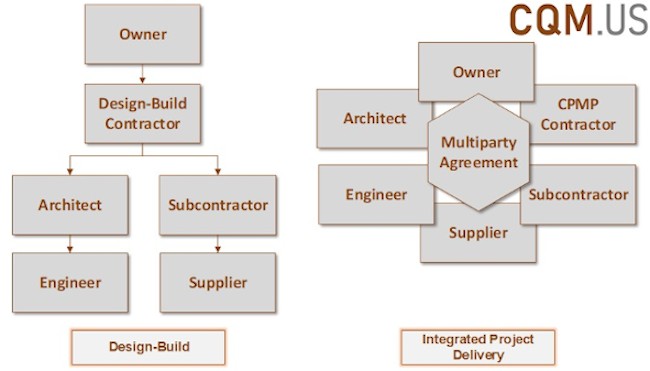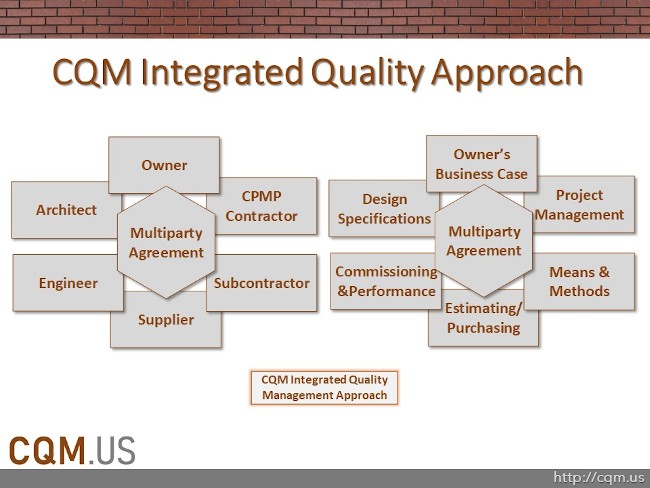CQM Project Structure recommendation is in line with an Integrated Project Delivery approach for shared Risks and Quality efforts. Understanding CQM Project Structure will help in comprehending the CQM Phases where the need for a Quality Management effort in different phases of a Construction Project is explained.
Traditional Construction Project Structure
The Traditional Construction Project Structure is a very rigid and formal format where communication is restricted by contractual agreements. Contracts place risks and define responsibilities for expected service and quality from each entity in separate buckets. To better define these boundaries, owners would have separate contracts with entities that would hire their subs to complete the job. In an attempt to improve the speed of decision making in the Design process and lay the risks on the General Contractor new Design-Build Delivery systems were introduced.

Neither system guaranteed a smooth and integrated quality management assurance for the owner. Depending on a role, whether it is Business Manager, Developer, Regulator, Legal Console, Architect, LEED Expert, General Contractor, Subcontractor, Inspector, Supplier, Project Manager, BIM Modeler, Scheduler, Quality Manager, Engineer, Technician or Laborer each entity has its own perspective on Construction Project Phases depending on its accountability and responsibilities.
Integrated Project Delivery
As technology and best practices advanced, the variety of systems, designs, specifications, brands, methods, and techniques made it more difficult to control all the requirements and expectations for the owners. The cost of quality was also rising with more expensive litigations and legal barriers where contract boundaries increased mistrust and blame-game.
Therefore the Integrated Project Delivery approach was introduced as a need to form partnerships in Projects and collaborate as people and businesses to increase value to the owner by reducing waste, maximizing efficiency through all phases of design and construction. Therefore, depending on the industry’s perspective, Lawyers, Engineers, Architects, Contractors have their own IPD definition that’s why no single system is available and many organizations have developed their own, such as ASCE, AIA, CMAA, LCI, and AGC.

CQM Project Structure
CQM.US Experts also advocate an Integrated Project Delivery approach to Construction Projects to Integrate Quality Management. A common perspective can be created if the entire team has a partnership mindset in an Integrated Project Delivery approach where Quality has Integrated into the Construction Project Management to provide Sustainability by taking Profit, People, and the Planet into consideration.
CQM Methodology’s approach to Sustainability will be discussed at a later time, but to bring all CQM Team’s perspective to the same level, here is the CQM Project Structure recommended in the CQM Framework.

The Owner’s Business Case Requirement will be best met if a Construction Project Management Professional is onboard for Project Management and everyone is sharing the Quality Responsibility in a Multi-layered System of Quality Control and Quality Assurance Framework.
All that said, the CQM Methodology will be applicable to all different types of Project Structures since the Multi-layered System of QA/QC Framework is based on defined CQM Phases that will be covered next!
